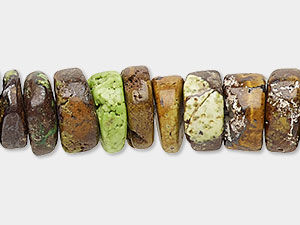Gaspéite Meaning and Properties
Gaspéite History
Gaspéite is a rare mineral, found in only a few places. Pronounced GAS-pee-ite, it was named after its original location of discovery, the Gaspé Peninsula of Quebec, Canada. Gaspéite is a bright yellow to apple green color with brownish veining. It was originally considered only a gangue mineral—a stone which contains a unextractable metal ore in its makeup.
Visually, gaspéite is similar to dyed forms of magnesite (which is a related gemstone material), but its density is higher (similar to that of garnet) as is its hardness (closer to that of apatite). It is most commonly shaped into cabochons and other larger stones.
What are the Metaphysical Properties of Gaspéite?
Gaspéite has been traditionally used among Australian Aboriginal peoples as a vision stone. Gaspéite meaning is also associated with healing and weight loss. Gaspéite meaning is affiliated with the heart and solar plexus chakras.
What is Gaspéite Made From?
Discovered in 1977, gaspéite is one of the newer gemstones on the market. The presence of gaspéite indicates to the mining community the area contains nickel-rich minerals. Artistically, this brittle stone displays perfect cleavage in three directions, making it easy to cut—and also sensitive to impact.
Other than the original deposit in Quebec, gaspéite can be found in Australia, Greece, Italy, South Africa and the state of New Mexico in the United States.
|
|
|
|
|
|
|
|
|
|
|
|
|
|
|
|
|
|
How Do You Clean Gaspéite?
Gaspéite is part of the calcite group and, like other carbonates, is sensitive to impact and acids. Although higher on the Mohs Hardness Scale than other carbonates, gaspéite is also a brittle, easy to cleave stone. It should be treated with the same care as apatite or opal.
As most dust is made of quartz-based particles, simply wiping this stone can cause scratches. Use a damp cloth to pat the stone to first clean and then dry it. Avoid ultrasonic and steam cleaners, as well as bleach or other household chemicals. Remove jewelry containing this stone before perspiring. Wrap in a soft cloth or fabric-lined box to store.
Gaspéite FAQ
Q: Is gaspéite rare?
A: Gaspéite is a rare gemstone found in only a few locations worldwide.
Q: Is gaspéite a birthstone or associated with any zodiac sign?
A: Gaspéite has no associations with birthstones or zodiac signs.
Q: Is gaspéite popular in Native American jewelry?
A: While gaspéite is a recently discovered gemstone, it has found its way into Native American designs. With its striking pale green hue, it looks gorgeous next to the more traditional turquoise and silver in inlaid designs.
Designing with Gaspéite
This stone's softness and sensitivity to impacts make it best showcased in earrings, brooches and shorter necklaces. A number of techniques can be used to prolong the life of gaspéite, including stringing on silk thread, knotting between beads or using bead caps or stringing with similarly soft materials such as opals, pearls, malachite and turquoise. It can also be set into tall bezels that will protect the stone.
Shop for Gaspéite
**Please note that all metaphysical or healing properties listed are collected from various sources. This information is offered as a service and not meant to treat medical conditions. Fire Mountain Gems and Beads® does not guarantee the validity of any of these statements.
How did you like this resource? Your feedback helps us provide resources that matter to you most.
Copyright Permissions
All works of authorship (articles, videos, tutorials and other creative works) are from the Fire Mountain Gems and Beads® Collection, and permission to copy is granted for non-commercial educational purposes only. All other reproduction requires written permission. For more information, please email copyrightpermission@firemtn.com.

